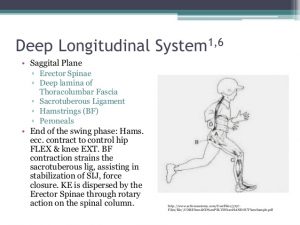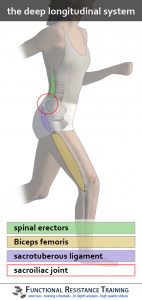One of the ways we can look at back health and saving our back is take our attention to the deep longitudinal system.The dominant role of the deep longitudinal system is to control ground reaction forces during gait motions. The posterior oblique subsystem works synergistically with the deep longitudinal subsystem distributing transverse plane forces created through rotational activities.

If looking in isolation the Deep Longitudinal Sling is made up of….
Anterior Tibialis
Peroneus Longus
Biceps Femoris
Sacrotuberous Ligament
Contralateral Erector Spinae
Together these muscles work as stabilizers of the hips and core. This is mainly seen as we walk, these muscles absorb energy from the ground and transfer it up the body. Where the energy being set up will dissipate before reaching the head if the core is acting properly.

A way of understanding this is to look at our walking, when we walk we have low activation of the inner unit which in turn provides enough stiffness to protect the joints and provide support for the outer units. On walking when we swing one leg forward there is a counter rotation with the opposing arm. Prior to the foot strike, the hamstring becomes active. The deep longitudinal system uses the thoracolumbar fascia and paraspinal muscle systems to transmit kinetic energy above the pelvis while using the biceps hamstring as a communicator between the pelvis and lower limb.

The Biceps Femoris has a special value in the stabilization of the hips. As the Biceps Femoris is contracted the sacrotuberous ligament is pulled down with it. This forces closure of the Sacroiliac Joint (SI Joint). Dorsiflexion of the foot activates the biceps femoris just prior to heel strike therefore serves to ” wind up” the thoracolumbar fascia mechanism as means of stabilising the lower extremity and storing kinetic energy that will be released in gait.
RECOMMENDED EXERCISES
Any exercises that train the lateral system will be useful to both prevent and overcome SI joint dysfunction.
Develop stability – the time-under-tension (TUT) for each set should be at least 120 seconds.
Progress to strength training – the TUT should be 60 seconds or less. The less TUT a client can hold when performing an exercise, the higher the intensity is for that particular exercise.
WORKING WITH CLIENTS WITH SI JOINT DYSFUNCTION
The CHEK formula of Flexibility-Stability-Strength-Power should be used with all clients.
“If you are not assessing, you are guessing!” – Paul Chek
Get in touch and book your discovery call today!
Bibliography
Scientific Core conditioning – Paul Chek





